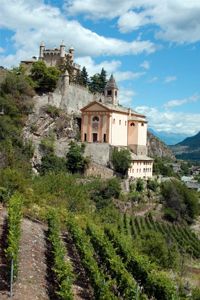Sicily -- if your first thought about the largest island in the Mediterranean Sea is a certain group of gangsters in the "Godfather" trilogy, you're in for a treat. The island's location has helped it become one of the world's most diverse melting pots. At one time or another, it was inhabited by the Siculians (after which it was named), Phoenicians, Greeks, Romans, Byzantines, Arabs, Normans, Germans and Spanish. In 1860 it became part of the new Italian state. All of these cultures contributed to Sicily's history and influenced the production of wine throughout the region -- though not all of their influences were positive.
The Strait of Messina separates Sicily from the Italian mainland. At its narrowest point the strait is a mere 2 miles (3.2 km) wide [source: Britannica], so you can stand on either shore and easily see the other. Recent plans have been put in motion to build a 3.2-mile (3,666-meter) bridge that will connect the island to the rest of Italy. When it's finished in 2012, it will be the longest bridge in the world [source: Frittle].
Advertisement
Wine is one of Sicily's greatest contributions to the world. This is in large part because of its soil, which is ideal for growing grapes but almost useless for the cultivation of any other crops. If the soil were richer, wine production might never have evolved on the island as it did. The mild Mediterranean climate also helps, as do the mountains and hilly terrain, which provide ideal locations for vineyards.
Of all the wines that Sicily has to offer the world, the most famous are dessert wines. In fact, the majority of DOC wines from the island are sweet wines, such as Marsala -- which was largely responsible for bringing worldwide attention to Sicilian wines. (See page 4 for more about the DOC system.)
Today, vineyards cover 329,923 acres (134,000 hectares) of Sicilian land and produce a whopping 213 million gallons (806 million liters) of wine every year [source: Wine Country]. The region is in constant competition with the Apulia wine region to produce the most wine in Italy.
Check out the next page to learn about the history and culture of Sicily.
Advertisement


